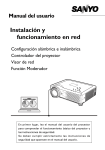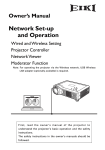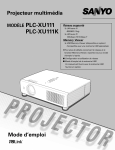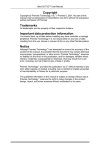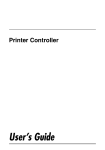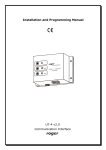Download Abocom WB2000 User's Manual
Transcript
802.11b Wireless
CardBus PC Card
Quick Installation
M73-APO01-500
REGULATORY STATEMENTS
FCC Certification
The United States Federal Communication Commission (FCC)
and the Canadian Department of Communications have
established certain rules governing the use of electronic
equipment.
Part15, Class B
This device complies with Part 15 of FCC rules. Operation is
subject to the following two conditions:
1) This device may not cause harmful interface, and
2) This device must accept any interface received, including
interface that may cause undesired operation. This
equipment has been tested and found to comply with the
limits for a Class B digital device, pursuant to Part 15 of the
FCC Rules. These limits are designed to provide reasonable
protection against harmful interference in a residential
installation. This equipment generates, uses and can radiate
radio frequency energy, and if not installed and used in
accordance with the instructions, may cause harmful
interference to radio communications. However, there is no
guarantee that interference will not occur in a particular
installation. If this equipment does cause harmful
interference to radio or television reception, which can be
determined by turning off and on, the user is encouraged to
try to correct the interference by one or more of the
following measures:
Reorient or relocate the receiving antenna.
Increase the distance between the equipment and receiver.
Connect the equipment into an outlet on a circuit different
from that to which the receiver is connected.
CAUTION:
1)
2)
To comply with FCC RF exposure compliance
requirements, a separation distance of at least 20 cm must
be maintained between the antenna of this device and all
persons.
This transmitter must not be co-located or operating in
conjunction with any other antenna or transmitter.
Installing the Utility
Precaution: Installing the Adapter's utility
before installing the device is highly
recommended for saving your time.
Precaution for Windows XP users:
There are two options for you to choose:
c Follow below instructions to install the utility.
d Skip this section. Go to Installing the
Device – Manually - In Windows XP section
to install the device, and then you can use the
built-in utility in Windows XP.
1. Insert the Setup Utility CD-ROM into the
CD-ROM drive and double click on
Setup.exe to install the Wireless LAN
Utility.
2. When the Welcome screen appears, click
Next to continue.
3. The Choose Destination Location screen
will show you the default destination chosen
by the utility. Click Next to continue.
4. Follow the instruction to select the program
folder. Click Next to continue.
5. In Start Copying Files, click Next to
continue.
6. In Setup Status, the InstallShield Wizard
will begin copying the files.
7. Click Finish.
-1-
Installing the Device
Automatically
If the Application setup in Installing the
Utility section has been completed, follow
below steps to install the device.
1. Locate the CardBus slot of your system.
2. Align the Wireless PC Card toward the
CardBus slot. Push evenly and steadily until
it is seated.
After the device has been connected to your
computer, Windows will detect the new hardware
and then automatically copy all of the files
needed for networking.
For Windows 98 users: As you perform the
installation, have your system operating
CD-ROM at hand. You may be asked to insert
the OS CD-ROM for the system to download a
specific driver.
For Windows 2000 users: When Digital
Signature Not Found screen appears, click
Yes to continue.
For Windows XP users:
1. Select Install the software automatically
(Recommeded) and click Next.
2. Click Continue Anyway.
3. Click Finish to complete the installation.
-2-
Manually
If you want to install the device before
installing the utility, please follow below
sections.
1. Locate the CardBus slot of your system.
2. Align the Wireless PC Card toward the
CardBus slot. Push evenly and steadily until
it is seated.
After the device has been connected to your
computer, Windows will detect the new hardware
automatically.
In Windows 98
1. In Add New Hardware Wizard, click Next.
2. Select Search for the best driver for your
device (Recommended). Click Next.
3. Insert the device driver CD-ROM into the
CD-ROM drive. Select CD-ROM and
Specify a location: and click Browse to
provide the appropriate path (e.g.
D:\Win9xMe). Click Next.
4. Click Next, Windows will copy all the
necessary files to your system.
5. Insert Windows 98 CD-ROM, and then click
OK.
6. Click Finish to complete the installation.
7. When Windows prompts you to restart your
computer, click Yes.
-3-
In Windows ME
1. Select Specify the location of the driver
(Advanced), click Next.
2. Insert the device driver CD-ROM into the
CD-ROM drive. Select Search for the best
driver for your device (Recommended)
and click Browse to provide the appropriate
path (e.g. D:\Win9xMe). Click Next.
3. Click Next, Windows will copy all the
necessary files to your system.
4. Click Finish to complete the installation.
5. When Windows prompts you to restart your
computer, click Yes.
In Windows 2000
1. In Found New Hardware Wizard, click
Next.
2. In Install Hardware Device Drivers, select
Search for a suitable driver for my device
(recommended), click Next.
3. Insert the device driver CD-ROM into the
CD-ROM drive. Select CD-ROM drivers
and Specify a location, click Next.
4. Click Browse to provide the appropriate path
(e.g. D:\Win2kXP). Click OK.
5. Click Next, Windows will copy all the
necessary files to your system.
6. In Digital Signature Not Found window,
click Yes to continue.
7. Click Finish to complete the installation.
8. Restart your computer.
-4-
In Windows XP
1. Once the device is well connected to your
computer, Windows XP will automatically
detect the new device. Select Install from a
list or specific location (Advanced) and
click Next.
2. Insert the device driver CD-ROM into the
CD-ROM drive. Select Include this location
in the search: and click Browse to provide
the appropriate path (e.g. D:\Win2kXP).
Click Next.
3. Click Continue Anyway to proceed.
Windows will copy all the necessary files to
your system.
4. Click Finish to complete the installation.
Configuration Utility
After installing the Wireless PC Card’s driver
successfully, the Network Status icon will
appear in the task bar. You can open it by
double-clicking on this icon.
Note: Except for the following configuration
utility, using Windows to configure the
wireless network settings in the Windows XP is
recommended.
(Please
skip
to
the
Configuration for Windows XP section)
-5-
Network Status Icon
The Status Icon
Icon
Link Status
Access Point mode. (Green)
Peer-to-Peer mode. (White)
No connection. (Red)
Link Info
The Link Info tab will display the current status
of the Wireless Network Adapter.
-6-
Item
Description
Status
It displays the information about the
status of the communication (the
BSSID of the Access Point to which
the card is associated).
SSID
The SSID is the unique name shared
among all points in your wireless
network. The name must be identical
for all devices and points attempting
to connect to the same network.
It shows the current SSID setting of
the Wireless Network Adapter.
Tx Rate
It shows the current transfer rate. (1,
2, 5.5, or 11Mbps or Auto)
Channel
It shows the selected channel that is
currently used. (There are 14
channels available, depends on the
country.)
Link Quality It displays the link quality of the
connection between the Wireless
Network Adapter and the Access
Point it connects.
Signal
It displays the signal strength of the
Strength
connection between the Wireless
Network Adapter and the Access
Point it connects.
Data Rate
It displays the current transmitting
and receiving rate.
Configuration
You can change advanced configuration settings,
such as the SSID, Operation Mode, Tx Rate
and Preamble Type.
-7-
Item
Description
SSID
SSID is the unique name shared among
all points in your wireless network. It
must be identical for all points in the
network. It is case-sensitive and must
not exceed 32 characters. Make sure
that all points in the network are set the
same.
Operating It displays the current operating mode.
Mode
(Access Point or Peer-to -Peer).
Channel
Tx Rate
Preamble
Select the appropriate channel from the
list provided to correspond with your
network settings. All devices in the
wireless LAN must be configured to
share the same radio channel in order to
work correctly. (There are 14 channels
available, depends on the country.)
Select (1, 2, 5.5, or 11Mbps or Auto)
from the pull-down list to change the
current transfer rate
A preamble is a signal used in wireless
environment to synchronize the
transmitting
timing
including
Synchronization and Start frame
delimiter. (Note: Please check the
setting of AP first.)
-8-
Item
Description
~ Auto
Select Auto for the Network adapter to
select the Preamble type automatically
depending on the Access Point
Preamble type.
If in a "noisy" network environment,
the Preamble Type should be set to
Long Preamble.
The Short Preamble is intended for
applications where minimum overhead
and maximum performance is desired.
If in a "noisy" network environment,
the performance would be decreased.
Select On/Off from the pull-down list
to enable/disable the Radio Module
function of the Wireless Network
Adapter.
~ Long
Preamble
~ Short
Preamble
Radio
Encryption
WEP (Wired Equivalent Privacy) encryption
can be used to ensure the security of your
wireless network.
-9-
Item
Data
Encryption
Description
WEP is a data privacy mechanism
based on a 64 Bit/128 Bit shared
key algorithm.
Check this box to enable WEP
encryption.
Auth. Mode
The authentication mode defines
configuration options for the
sharing of wireless networks to
verify
identity
and
access
privileges of roaming wireless
network cards.
You may choose between Open
Authentication,
Shared
Authentication, and Auto.
Open
If the Access Point is using "Open
Authentication Authentication”, then the wireless
adapter will need to be set to the
same authentication mode.
Shared
Shared Authentication is when
Authentication both the sender and the recipient
share a secret key.
Auto
Select Auto for the network
adapter to select the Authentication
mode automatically depending on
the Access Point Authentication
mode.
Key Length
64 Bit or 128 Bit.
WEP Key
This setting is the configuration
{1
key used in accessing the wireless
{2
network via WEP encryption.
{3
Fill in the appropriate value/phrase.
{4
Apply
Click Apply to save the changes.
Cancel
Click Cancel to exit the
application.
Note: You must use the same value/phrase or
WEP key settings for all wireless computers in
order for the wireless network to function well
- 10 -
Site Survey
The Site Survey tab shows all the available
Access Points and their features.
Item
Description
It displays the current SSID setting
SSID
of the Wireless Network Adapter.
It displays the status of WEP
WEP
Encryption.
It displays the selected channel that
Channel
is currently used.
It displays the signal strength of the
Signal
connection between the Wireless
Network Adapter and the Access
Point it connects.
BSSID/IBSSID A set of wireless stations is referred
to as a Basic Service Set (BSS).
Computers in a BSS must be
configured with the same BSS ID.
Type
It displays the type of Basic Service
Set. ( Access Point or
Peer-to-Peer)
- 11 -
Item
Re-Scan
Connect
Description
Search for all available networks.
Clicking on the button, the device
will start to rescan and list all
available sites.
Select one from the list to connect.
About
You can view basic information about the Utility like
the Driver and Utility Version.
Configuration for Windows XP
1. Go to Start Æ Control Panel Æ Network
Connections.
2. In
Network
Connections
window,
right-click
the
Wireless
Network
Connections icon, and select Properties.
3. In
Wireless
Network
Connection
Properties window, select the General tab.
- 12 -
Click Configure
configuration.
Property
Antenna
Channel
Data Rate
Network
Type
to
enable
Windows
Description
(Diversity, Antenna A or Antenna
B): These settings determine which
antenna will be used to transmit or
receive.
Select the appropriate channel from
the list provided to correspond with
your network settings. All devices in
the wireless LAN must be configured
to share the same radio channel in
order to work correctly.
(There are 14 channels available,
depends on the country.)
Select (1, 2, 5.5, or 11Mbps or Auto)
from the pull-down list to change the
current transfer rate.
Select the appropriate Network Type
from 802.11 AdHoc Mode (Active),
802.11 AdHoc Mode (Passive) or
Infrastructure.
In AdHoc mode, Active mode is
recommended
since
it
can
generate/pass
beacon
packets
automatically.
- 13 -
Preamble
A preamble is a signal used in wireless
environment to synchronize the
transmitting
timing
including
Synchronization and Start frame
delimiter. (Note: Please check the
setting of AP first.)
~ Auto
Select Auto for the Network adapter
to select the Preamble type
automatically depending on the
Access Point Preamble type.
~ Long
If in a "noisy" network environment,
Preamble
the Preamble Type should be set to
Long Preamble.
~ Short
The Short Preamble is intended for
Preamble
applications where minimum overhead
and maximum performance is desired.
If in a "noisy" network environment,
the performance would be decreased.
RTS
This value should remain at its default
Threshold
setting of 2347.
Should you
encounter inconsistent data flow, only
minor modifications of this value are
recommended.
Select Shared Select from 1, 2, 3, 4 or No selection.
key Index
Sharekey1
This setting is the configuration key
Sharekey2
used in accessing the wireless network
Sharekey3
via WEP encryption.
Sharekey4
Fill in the appropriate value/phrase.
SSID
SSID is the unique name shared
among all points in your wireless
network. It must be identical for all
points in the network.
It is
case-sensitive and must not exceed 32
characters. Make sure that all points
in the network are set the same.
WEP
WEP is a data privacy mechanism
based on a 64 Bit/128 Bit shared key
algorithm.
Select WEP key 128bit or WEP key
64bit to enable WEP encryption.
- 14 -
4. In
Wireless
Network
Connection
Properties window, select the Wireless
Networks tab.
Use Windows to configure…
*Use the Configuration Utility for 802.11b
Wireless CardBus PC Card
Note: If you want to use the utility in
Configuration Utility section to configure the
wireless settings. Make sure the check box is
NOT enabled (please refer to below figure),
and then the Network Status icon will appear in
the taskbar. You can open it by double-clicking
the icon.
- 15 -
* Use Windows to configure
Note: Right-click the Network Status icon in
the taskbar, click Disable Utility. The Network
Status icon in the taskbar will disappear, and
then you can use Windows to configure the
wireless settings.
Available networks
Displays all available networks.
- 16 -
Configure
Click the button to set up a new network or WEP
configuration as illustrated as below.
Refresh
Click the button to refresh and search for all
available networks.
Preferred networks
From available network(s) listed above, you can
select preferred one(s) in an order that you can
arrange.
The marked one is the currently used network.
Move up
Move the selected network forward one position.
- 17 -
Move down
Move the selected network back one position
Add…
Click the button and the Wireless Network
Properties window will appear.
In the
Network name field, enter your desired network
name listed in the above Available networks box,
and click OK.
Note: The new settings will be active only after
you click on OK in the Wireless Network
Connection Properties window.
Remove
Highlight the unwanted network listed in the
Preferred networks box, and click the button to
remove it.
Properties
Highlight the network listed in the above
Preferred networks box, and click the button to
display its properties.
Once network configuration is done, make sure to
click OK. The new parameters will be saved
and active only after doing so.
- 18 -
























